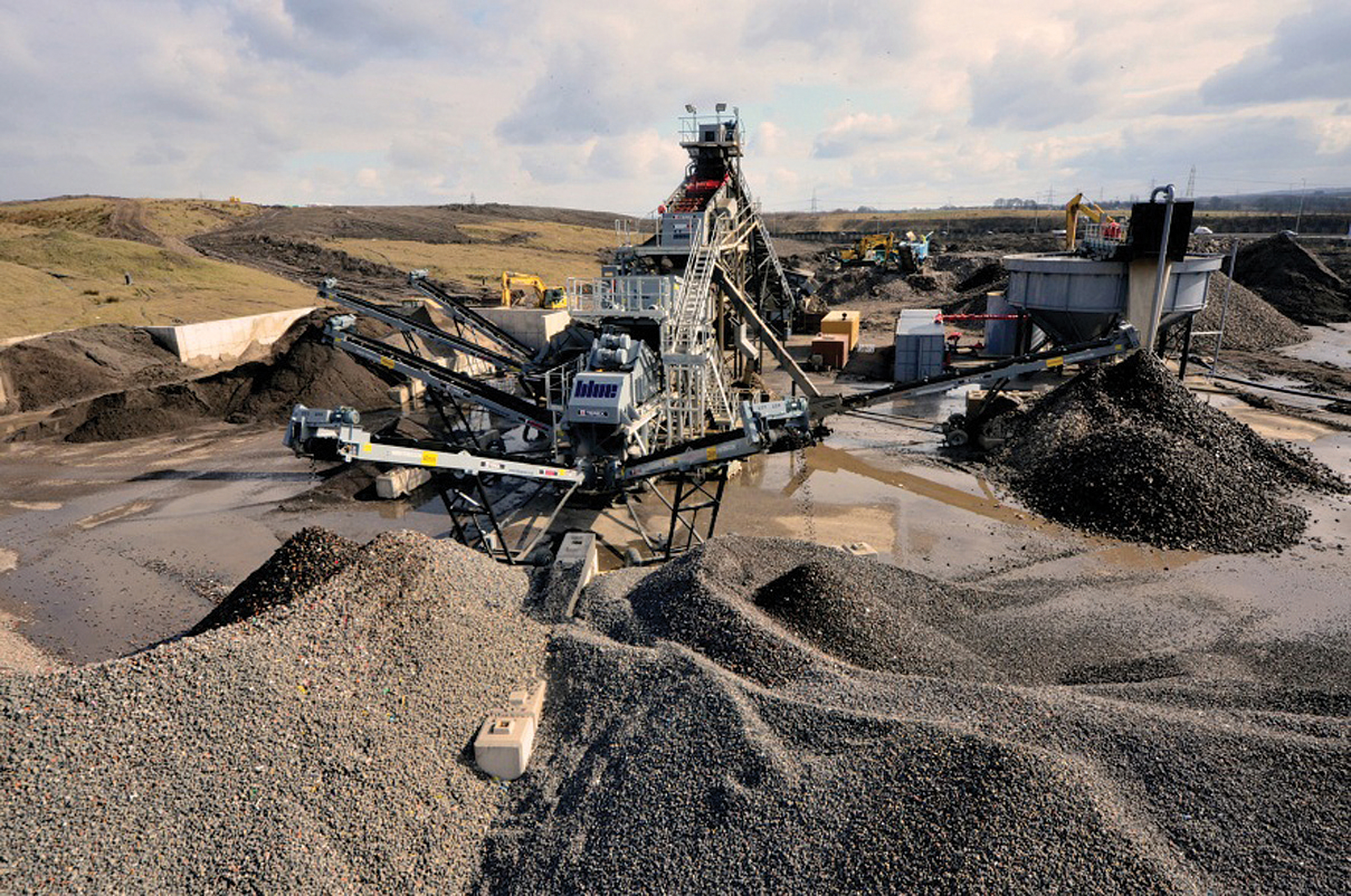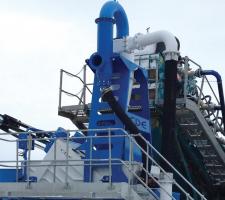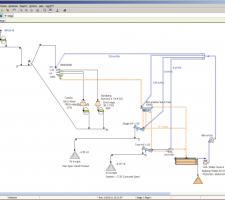
Aggregates used in concrete have to be strong, hard, and they must also be clean. This means that the products, including sand, should be free of chemicals, clays, and a variety of leached materials. If they are not, they could interact with the concrete and interfere with the way it sets, and this is why many contractors, and indeed job specifications, now demand only clean materials. Patrick Smith reports
Manufacturers of specialist washing systems have risen to the challenges by producing a wide variety of systems that produce top quality results.
Tony Locke, managing director of
“A combination of budget constraints across the supply chain and increasing environmental regulations is putting ever-increasing pressure on the bottom lines of mines and quarries around the world,” he says.
And
In Poland, Orlex Beton’s newly-installed EvoWash 71 sand washing plant from CDE Global is addressing inefficiencies with the sand washing phase of its production processes.
Supplied and installed by Biuro Handlowe Ruda, CDE sales partners for Poland, the new EvoWash 71 operates at 70tonnes/hour and produces a single 0-2mm washed sand for use in concrete production.
The company is based in Wejherowo, 50km north of Gdansk, and the growing demand for the range of concrete products it manufactures has seen many new developments in recent years including in 2011 the installation of a new mobile concrete manufacturing plant in Pomorskie, 40km to the west of Gdansk.
Prior to installation of the new plant, Orlex Beton was losing substantial quantities of good material to the settling ponds. In addition to the costs associated with losing quality sand, the company was faced with a number of other issues which added significant cost to production.
“We have a relatively small area available for settling ponds and as a result of the volume of sand we were losing we had to try and recover material from the ponds every day to ensure we could continue to operate,” explains Michal Gebarowski, owner of Orlex Beton.
“This was creating problems for our wheeled loaders as a result of the extra work they were having to do so it was essential that we found a solution to these problems. BH Ruda was able to demonstrate to us how the Evowash had been applied on this type of application on many other projects and I am very happy to say that the new plant is performing as promised.”
The new EvoWash sand washing plant receives 0-2mm material from the existing processing plant and total plant production is around 150tonnes/hour. This fraction makes up approximately 50% of the total sand and gravel feed with the remaining material classified into 2-8mm, 8-16mm and +16mm aggregates.
The ability of the EvoWash to effectively classify the 0-2mm material and produce a washed sand for use in concrete has allowed Orlex Beton to introduce efficiencies to its own concrete production processes.
“By effectively removing the 0-63micron fraction and maximising recovery of the 63 micron to 2mm fraction Orlex Beton is now producing more material while at the same time eliminating the requirement to embark on expensive daily pond dredging operations,” says Jarek Modrzejewski of BH Ruda.
An additional benefit of the new installation has been a reduced requirement for Orlex Beton to buy in sand and aggregates for use in concrete production.
With the new sand washing plant the reduced moisture content of the final sand product has eliminated the requirement for double handling of the final product, which previously had to be moved to stockpile and left to dry before being loaded.
“The fact that we can now use the sand product immediately after it has been produced has not only streamlined our concrete production processes but created further efficiencies as a result of removing the requirement to handle the product twice in order to ensure it was dry enough” says Gebarowski.
“The feedback we are getting from our customers indicates that there is an industry-wide recognition that investment in new equipment as a means of reducing costs is not only viable but essential” says CDE sales director, Enda Ivanoff.
“Our project for Orlex Beton is a good example of the benefits to be gained from this approach.”
TWS’ AggreSand
Terex Washing Systems’ AggreSand system combines aggregate washing and screening with sand processing on a modular chassis (see Equipment Update).
Meanwhile, a TWS 150tonnes/hour recycling wash plant, operating ten hours-plus/day, has been installed in association with its Scottish dealer Blue Machinery (Scotland) for independent quarrying company Paterson’s Quarries at its Greenoakhill Quarry and Recycling Centre, Glasgow.
Austin Carey, managing director, Blue Machinery (Scotland), said: “We are delighted to continue our close working relationship with Paterson’s of Greenoakhill in supplying this new TWS washing plant for its new materials recovery centre at Greenoakhill.”
A bespoke TWS plant is processing tens of thousands of tonnes of construction, demolition and excavation waste to produce four grades of stone and two grades of sand with the new Commonwealth Games construction and demolition aggregates recycling plant.
“On careful analysis of the feed material and being mindful of the large variation in the silt content, it was established that specific attention was necessary when choosing the sand plant,” says Fergal McPhillips, sales manager for TWS.
“With this in mind a flexible sand plant with a special pre-wash option was sure to be the perfect solution. Based on these findings TWS proposed a bespoke system which is now ensuring that the construction and demolition waste material is being effectively processed and is producing saleable aggregates and sand.”
Garry Stewart, applications and sales support engineer, TWS admitted that the high silt content of Paterson’s construction and demolition material was a challenge which TWS relished.
“We knew we had the expertise and technology to convert this sticky clay-bound material into saleable building materials. The Paterson’s material is hugely variable and it was critical that we designed and manufactured a plant which could handle these variations. On a recent site visit we witnessed at first hand the quality of clean aggregate and sand being produced.”
At the site extensive initial testing and sieve analysis highlighted that the material to be processed had a very high silt content of 30% plus. After consultation with Blue Machinery (Scotland) and Paterson’s, and vigorous analysis on the feed product, TWS proposed its range of cyclone separators and utilised a pre-wash to manage the silt (less than 63micron material).
“The Paterson’s plant is a demonstration of what can be achieved from initial conception through to the production of high quality products,” says Sean Loughran, director of TWS.
The end products are being sold into the market for construction projects and groundwork contracts throughout Glasgow as well as being used in Paterson’s Readymix and its concrete block-making operations. The TWS completes the recycling process with construction, demolition and excavated material taken from sites around Glasgow, which is processed and is then returned to those sites in the form of clean, sized aggregate for drainage, ready-mixed concrete, concrete blocks and asphalt.
Director Tom Paterson says: “As a major supplier of construction materials into the central belt, the new aggregates recycling plant is an important investment for our company to ensure we are able to offer a sustainable source of high quality coarse and fine aggregate. Our location is ideally suited to minimise haulage to and from the market we serve, whether this is for the excavations coming off site or for supply of material back to site. The aggregates plant gives our site a new lease of life and will ensure a long-term supply of high quality material for our customers and for our own complementary business of ready-mixed concrete and concrete blocks.”
Material Matters
Weir Minerals says it is also addressing the challenges facing mine and quarry operators of raising output while reducing operating costs.
To this end it has launched a new strategic R&D initiative called Material Matters, saying the innovative campaign sets out its commitment to constantly improving efficiency by listening to operators, bringing advanced engineering and site expertise together and developing products and materials that deliver optimum performance.
Indeed, it has introduced a host of “cutting-edge pumps” and process equipment, including the latest development in the Warman slurry pump range, the Warman WGR pump.
The state-of-the-art pump features a series of innovations that are said to make maintenance quick and easy to perform, while the Warman WBH pump, a new generation heavy-duty slurry pump, builds on the success of the Warman AH slurry pump. It is said to add a dozen separate enhancements to the design to help optimise performance, power usage, wear life and ease of maintenance.
“Many operators are looking at the equipment they are using and focusing strongly on ensuring it is as efficient as possible in order to increase production and cut energy consumption,” says Tony Locke.
“As one of the biggest suppliers of process equipment to the mining and quarrying industries, we take our role in this process extremely seriously, and it is this commitment that underpins the Material Matters campaign.”
Meanwhile, AggFlow has expanded its wash and water capabilities to include important new features for managing this critical resource in plant operations.
AggFlow is used worldwide by aggregate producers and process engineers to simulate plant operations and enhance overall productivity.
The company says it allows the users to calculate mass aggregate and water balances flowing through a plant simulation using both stationary and mobile equipment.
Building a simulation which calculates the theoretically perfect scenario, then comparing that scenario to actual operating results allows users to identify bottlenecks and inefficiencies in the plant operation and to optimise and maximise overall production.
“AggFlow allows plant managers and process engineers to accurately determine the impact of changes to wash and water equipment in the process flow and the resulting products,” says George Fox, process control manager at Luck Stone Corporation.
“It is especially useful to track the total water mass balance in the plant and determine the make-up water rate required to keep the plant in balance.”
The program incorporates many different aspects of water processing in its calculations including log washers, sand screws, classifiers, clarifiers and the entire range of scrubbing and attrition as well as sand washing and dewatering machines.
The program also incorporates pumps, spray bars, cyclones and various other features to customise water processing calculations and track water mass balance.
The program is said to be useful for both plant management and new plant design.
“I use these features of the program constantly: AggFlow allows design engineers to accurately determine the size and operating parameters of the wash and water equipment needed to meet plant design specifications and ensure correct end-product results,” explains Jim Deveraux of JD Engineering.















